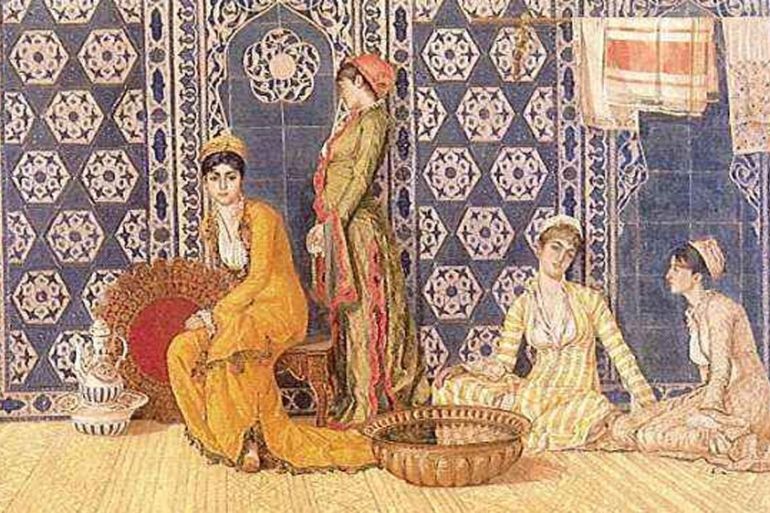The harem is not what you think it is
It was simply the private part of any household big enough to distinguish between private and public quarters.

On March 9, Emine Erdogan, first lady of Turkey, participated in a conference entitled “Sultans’ Mothers who Have Left Traces on Our History” in Ankara. She said:
“[Our] past can inform … [our] future … Orientalists have produced inappropriate impressions in people’s minds … [of] women drawn to worldly pleasures and power. However, the harem was more of a school for its members. It was the hearth of education, where women prepared for life and organised charitable events … with sultans’ mothers at the helm … [whom we know] largely because of the architectural works they left behind.”
Keep reading
list of 4 itemsInside the pressures facing Quebec’s billion-dollar maple syrup industry
‘Accepted in both [worlds]’: Indonesia’s Chinese Muslims prepare for Eid
Photos: Mexico, US, Canada mesmerised by rare total solar eclipse
Coming the day after International Women’s Day, when her husband Recep Tayyip Erdogan essentialised women’s social roles through the statement that “a woman is above all a mother”, Emine Erdogan’s speech aroused much liberal derision.
Yet, immediate objections to the equation of the harem with a school do not address the broader problematic of romanticising the Ottomania dominating current Turkish presidential rhetoric.
The curse of Orientalism
In the 18th century, Antoine Gallard’s translation of A Thousand and One Nights fuelled fantasies of the orgiastic harem, yet English artist Lady Wortley Montagu and French philosopher Montesquieu used the East as exemplary for European progress.
This perspective shifted under 19th century colonialism, when painter Eugene Delacroix’s Women of Algiers (1834) signified French conquest through entry into the private sphere of an Algerian home.
In suggesting the harem as a model for the present, Erdogan establishes a populist red herring against an imaginary Western onslaught, as if to say that current concerns about the rights of women are due to this misrepresentation.
Thereafter, numerous Orientalist painters and novelists developed a fantastic repertoire of the harem that increased with the eroticisation of belly dancing at the 1889 Paris World’s Fair.
Writing of his European travels in 1895, the Ottoman journalist and writer Ahmed Midhat Efendi complained that, “the symbol of the East is a beloved sprawled on a couch … Since her clothing reveals more than it conceals, just as her legs hang from the couch spread apart, her belly and her chest are only half-covered with transparent gauzy fabrics as thin as a dream … However, much contact with this image gives the pleasure of beautiful things to the eyes, it is not a reality, but a dream, a poem … For one would think that this body is not the wife of her husband and the mother of her children, but perhaps only a plaything to serve the pleasures of the man who owns the house”.
For the harem was simply the private part of any household big enough to distinguish between private and public quarters, where male guests might be received in its corollary, the “selamlik”.
A wealthy household might include multiple wives, as well as multiple generations, all of which would have separate financial and social arrangements.
After the 16th century, sultans stopped marrying in order to limit family power. Thus, the sultan’s harem, to which Erdogan refers, was composed largely of children, servants, slaves – some of whom who rose through the ranks of concubinage to become mothers of sultans, regulating the harem and its very un-libertine, procreation-oriented sexuality.
Like any household, royal or not, harems were educational spaces, and women of varying social status learned basic household tasks as well as reading, in order to study the Quran. Elite women also participated in a culturally sophisticated social milieu that included recitation of poetry and administration of inheritance and property.
Another misrepresentation
Yet, it is a far stretch to equate the household education of any harem, including the Ottoman dynastic harem, with a school.
Schools are modern institutions. In the 19th century, a centralised system of modern secondary education proliferated throughout the Ottoman Empire, supplementing the curriculum offered through traditional, religiously-oriented primary education in the “mektab” and the religious legal education offered in the secondary schools, or madrasas.
OPINION: The Middle Eastern century that wasn’t
Schools for women, teachers, and crafts emerged in the 1870s. Such schools were not geared towards elites, who continued to hire tutors at home, but to the urban population. For the first time, women, including members of minorities such as Armenians and Jews, began to work outside the home.
Today, rather than the harem, the Western trope of oppression for the Eastern woman is enslavement under the full-body veil.
OPINION: The empire must not strike back
The only people fully playing out this fantasy seem to be the soldiers of the so-called Islamic State of Iraq and the Levant (ISIL) group, who include among their military rewards a harem of enslaved women, the likes of which have never before been seen in the East.
In suggesting the harem as a model for the present, Erdogan establishes a populist red herring against an imaginary Western onslaught, as if to say that current concerns about the rights of women are due to this misrepresentation.

She, thus, belittles currently increasing patterns of sexual repression and violence against women in Turkey and much of the Middle East under conditions of war.
She also implies that the charitable acts of elites, like those of the Ottoman dynasty, can stand in for the rights of the many, largely secured through the modern educational opportunities called schools necessary in any modern democracy.
Equal access to education and participation in the public sphere for women and the working classes has been a hallmark of Turkey’s modern identity since its inception nearly a century ago.
Erdogan’s search for the future through the past is not shocking because of the lack of nuance in its information, but because it erodes the premises of a modern and egalitarian democratic state.
Wendy M K Shaw is a professor of the Art History of Islamic Cultures at the Free University, Berlin. She works on the art and thought of Turkey and the postcolonial Middle East, particularly in its relationship with historical remembrance.
The views expressed in this article are the author’s own and do not necessarily reflect Al Jazeera’s editorial policy.
